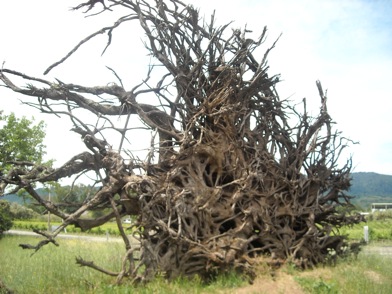Myth: Taproots Anchor All Trees

Some trees, such as walnuts, pecans and a number of pines and oaks are anchored by a deep, vertical taproot, but most fruit trees and many shade trees grow a fibrous root system. This is composed of a number of horizontal roots radiating out from the trunk with vertical or "sinker" roots growing along them at various intervals and extending out so that the wide root-system acts like a tripod to bolster the trunk and foliage. Examples of trees with such fibrous roots are: most popular deciduous fruit trees, poplar, locust, ash and Douglas fir. Many oak trees in arid areas have taproots when they are young, but switch to a horizontal-and-sinker root form as they get older. And any naturally-taprooted tree planted over a shallow soil with a barrier of clay, hardpan or rock will not grow its characteristic deep root.
The importance of sinker roots is not to be overlooked; Ed Gilman, Associate Professor in the Environmental Horticulture Department at the University of Florida, explains, “Wood is very strong when you try to pull it apart along the grain; imagine how hard it is to pull even a one-inch-diameter root straight out of the soil—the sinker roots really anchor the horizontal roots.”
With horizontal-and-sinker roots, watering at the very base of the tree isn't very helpful, and in the poor and shallow soils found in many yards, even taproots will travel far to the side to gather enough water and nutrients and to support the tree if obstructed below the surface. Confining the root zone with water and fertilizer close to the trunk diminishes the tripod effect of the horizontal-and-sinker root system. (For more, see my Roots Demystified book.)
|
 |
|

